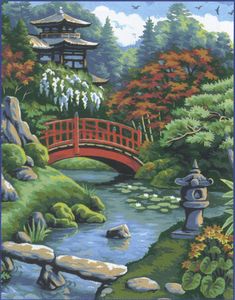Japanese Gardens

Characteristics
In addition to trees and shrubs, the Japanese garden makes artistic use of rocks, sand, artificial hills, ponds, and flowing water.In contrast to the geometrically arranged trees and rocks of a Western-stvle garden, the Japanese garden traditionally creates a scenic composition that, as artlessly as possible, mimics nature.
Garden designers followed 3 basic principles when composing scenes. They are reduced scale, symbolisation, and "borrowed views". The first refers to the miniaturisation of natural views of mountains and rivers so as to reunite them in a confined area. This could mean the creation of idealised scenes of a mountain village, even within a city. Symbolisation involves abstraction, an example being the use of white sand to suggest the sea. Designers "borrowed views" when they used background views that were outside and beyond the garden, such as a mountain or the ocean, and had them become an integral part of the scenic composition.
The basic framework of the Japanese garden, according to one school of thought, is provided by rocks and the way they are grouped. Ancient Japanese, we know, believed that a place surrounded by rocks was inhabited by gods, thus naming it amatsu iwasaka (heavenly barrier) or amatsu iwakura (heavenly seat). Likewise, a dense cluster of trees was called himorogi (divine hedge); moats and streams, thought to enclose sacred ground, were referred to as mizugaki (water fences).
Japanese gardens can be classified into 2 general types: the tsukiyama (hill garden), which is composed of hills and ponds, and the hiraniwa l (flat garden), a flat area without hills and ponds. At first, it was common to employ the hill style for the main garden or a mansion and the flat style for limited spaces. The latter type, however, became more popular with the introduction of the tea ceremony and the chashitsu (tea-ceremony room).
Gardens in Ancient Times
The earliest known gardens date back to the Asuka period (593-710) and the Nara period (710-794). In the Yamato area (now in Nara Prefecture), designers of imperial family gardens and those of powerful clans created imitations of ocean scenes that featured large ponds dotted with islands and skirted with "seashores". It was at this time that Buddhism was brought to Japan from the continent by way of the Korean peninsula. Immigrants from there added continental influences to Japanese gardens, such as stone fountains and bridges of Chinese origin.
Tea Garden
The tea garden, imbued with a quiet spirituality, was developed in conjunction with the tea Ceremony, as taught by Sen no Rikyu. It was through the tea garden, which avoided artificiality and was created so as to retain a highly natural appearance, that one approached the teahouse. Today's Japanese garden incorporates a number or elements inherited from the tea garden, such as stepping stones, stone lanterns, and clusters of trees. The simply designed gazebos in which guests are served tea also have their origin in the tea garden.
via: http://www.soundintermedia.co.uk/treeline-online/gardens.html
0 Comments:
Post a Comment
<< Home